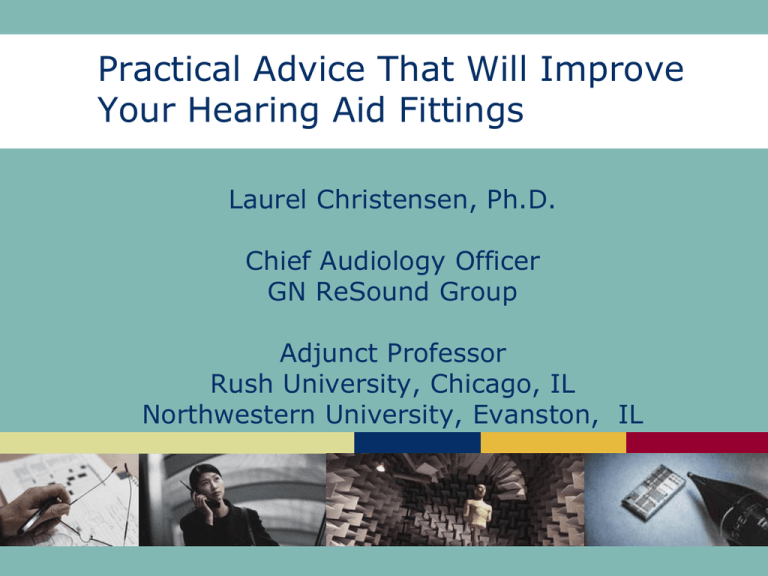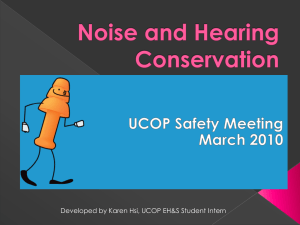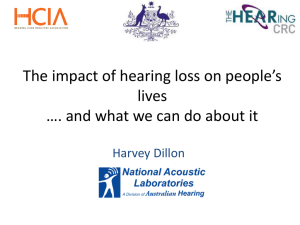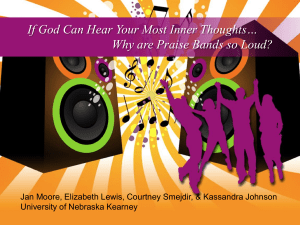Is this an easy fit?
advertisement

Practical Advice That Will Improve Your Hearing Aid Fittings Laurel Christensen, Ph.D. Chief Audiology Officer GN ReSound Group Adjunct Professor Rush University, Chicago, IL Northwestern University, Evanston, IL What is being set for you when you press Autofit? Gain Output Directional Settings – Beam Width – Bass Boost Noise Reduction Settings Feedback Suppression Settings Expansion Wind Noise Reduction Settings Memory Settings Steering Attack and Release Times ReSound Auto Fit Phonak Starkey – Quick Fit Gain/Output Settings for first time, comfort, experienced linear, experienced non linear have a major effect on the gain of the hearing aid. Rationale for acclimatization levels Experience with amplification affects acceptance Initially acceptable gain may be suboptimal for speech understanding First fit was never meant to be “last fit” Comfort User Experience – Non Linear Phonak – First Time User Phonak – Long Term Users Siemens – Level 1 Siemens – Level 4 Oticon – First Time User Oticon - Experienced Effect of experience level on targets Gain reduction for soft inputs: inexperienced user compared to most experienced user Moderate sloping hearing loss 0 -2 Reduction in gain (dB) -4 -6 HA 1 HA 2 HA 3 -8 -10 -12 -14 -16 100 1000 Frequency (Hz) 10000 Effect of experience level on targets Gain reduction for soft inputs: inexperienced user compared to most experienced user Flat severe loss 0 -2 Reduction in gain (dB) -4 -6 HA 1 HA 2 HA 3 -8 -10 -12 -14 -16 100 1000 Frequency (Hz) 10000 Effect of Experience Level Setting: First Fit Settings Two Hearing Aids – same audiogram Mild sloping to moderately severe HL 2cc coupler output with 65 dB SPL ISTS (international speech test signal) Effect of Experience Level Setting: Experienced settings two hearing aids – same audiogram Mild sloping to moderately severe HL 2cc coupler output with 65 dB SPL ISTS (international speech test signal) Audibility Targets on the screen are not always what is actually in the ear. One study says less than 12% of targets on the screen matched what was in the ear. (Aarts and Caffee, 2005) A more recent study – Moore et al., 2008 showed similar results – that is what is on the screen usually isn’t what is in the ear. Top 10 reasons why clinicians do not run real ear 10.) Unclear on test result interpretation or how to convey results to patients/Think digital cant be verified by real ear 9.) Not knowing when to verify 8.) Perceptions that the measurement/probe placement may be uncomfortable for patients 7.) Changing technology (open fits, digitals, etc.) negate the use of real ear 6.) Measures do not = more sales 5.) Can't bill for specific procedure 4.) Lack of confidence in procedures 3.) Do not own up-to-date equipment 2.) Who cares what the verification measure says if patient is happy 1.) Time Gain Verification REIG is the gold standard Compare measured values to predicted gain values Ensures optimal performance of the instrument Does little to convey a message to patients regarding how the instruments will help them REUG REIG Speech Mapping Today – Many system available and they go far beyond REIG Speech Mapping Provides information regarding targets for aided listening Uses output rather than gain – Includes interactions from various algos “real world” test signals can provide a more personal fitting technique – Spouse’s voice – Environmental sounds (paper rustling etc) Display of results provides a useful talking point for counseling Goals of Level Dependent Amplification Soft Sounds should be audible Moderate sounds should be comfortable Loud sounds should be loud but not intolerable Test signals can be presented at levels comparable to “soft” “medium” and “loud” Provides real-time analysis of hearing aid performance with features activated or deactivated as desired Verification using the audibility area To verify soft speech is audible – Deliver babble stimulus with VC set to low (50 to 55dB SPL) – Response curve should be at the lower level of the audibility area To verify moderate speech is comfortable – Deliver babble stimulus with VC set to the middle (65 to 70dB SPL) – Response curve should be covering the audibility area To verify loud sounds are tolerable – Deliver airplane stimulus with VC set to middle (~90 dB SPL) – FFT peaks should not exceed the UCL values Speech Mapping-Aurical VSM 10 dB threshold Speech Banana Customized Speech banana Speech Mapping-Aurical VSM 85 dB 53 dB 67 dB Speech Mapping Digital Feedback Suppression Demonstrates how DFS can reduce feedback while not notching out the frequency response Also demonstrates the amount of headroom that can be gained through the use of DFS technology Enable probe mic but do not use any stimulus Turn off all algos Increase gain to the point of feedback measure output Turn on DFS measure output Turn up gain if headroom demonstration is desired Digital Feedback Suppression Dynamic Feedback Measurement Directionality Incorporates 2 or more microphones into the hearing instrument in order to determine the direction of the signal of interest – Typically monitors the time difference between microphones In directionality mode, the hearing instrument will reduce gain of signals presented from behind and/or to the sides of the individual 3% of time hearing instruments are wired backwards – Verifying directionality before fitting will catch this problem Directionality and low freq equalization Directional Microphone Noise 2-mic directionality with low frequency roll off Traditional L/f compensation + Good Audibility - High Noise + Low Noise - Reduced Audibility Hz Directional Test Setup Verify with a single noise signal presented behind the patient – Turn chair to 180˚ Present ANSI speech noise or babble at 65 dB SPL – Present stimulus with directionality ON – Present stimulus with directionality OFF Curve obtained with directionality ON will have a smaller amplitude than the curve obtained with directionality OFF Directional Test Setup Directionality Noise Reduction Demonstrates how noisy signal levels are reduced through the use of this algorithm Use continuous noise – White noise – Test with all other algorithms disabled – Obtain 2 measurements • 1st with noise reduction disabled • 2nd with noise reduction set to strong Patient may hear as well as see the impact of this algorithm Four approaches to reducing noise 2 2 0 -2 RANDOM BABBLE 0 -6 High versus OFF (output change) ON versus OFF (output change) -4 -8 -10 -12 -2 -4 -6 -14 -16 random-85dB babble-85dB -18 -8 -20 -10 125 250 500 1000 2000 4000 8000 125 250 500 Frequency(Hz) 1000 2000 4000 8000 Frequency(Hz) 2 10 0 DIFFERENCE (dB,1/3octave) 0 ON versus OFF (output change) -2 -4 -6 -8 85dB random 85dB babble -10 -20 85dB RANDOM 85dB BABBLE -30 -10 125 250 500 1000 2000 4000 8000 -40 125 250 500 1000 Frequency(Hz) Frequency(Hz) 2000 4000 8000 Noise Reduction Wind Noise Reduction Hearing aid wind noise is caused by turbulent air flow around the microphone. This turbulence will result in movement of the microphone diaphragm that will in turn be amplified This amplification can overload the hearing aid resulting in wind noise The amount of wind is dependent on wind speed An effective demonstration can be performed in office using a motorized fan The effect of the wind generated by the fan can be measured using a probe microphone system Compare the measurements with and without WNR activated Can also be used to demonstrate how microphone placement effects wind noise Wind Noise Reduction Algorithm Conclusions Auto Fit is only a place to start and shouldn’t be for many patients an ending point. Acceptable Noise Level Acceptable noise level (ANL) is defined as the maximum level of background noise that an individual is willing to accept while listening to speech. The ANL measure assumes that speech understanding in noise may not be as important as is the willingness to listen in the presence of noise. ANL The ANL is established by adjusting a recorded story to the listener’s most comfortable listening level (MCL). Then the background noise is added and adjusted to the highest acceptable background noise level (BNL) while the listener is following the words of the story. The ANL, in decibels, is calculated by subtracting the BNL from the MCL. What Can It Tell You? Predictor of hearing aid success People who accept background noise have smaller ANLs and tend to be "good" users of hearing aids People who cannot accept background noise have larger ANLs and may only use hearing aids occasionally or reject them altogether Useful for counseling and setting realistic expectations Mueller et al., 2006 reported reduced ANLs when digital noise reduction was activated. Freyaldenhoven et al., 2005 showed ANLs can be improved with the use of directional hearing aid technology Hearing Aid Outcomes Issues in Evaluating the Effectiveness of Hearing Aids in the Elderly: What to Measure and When – Larry Humes, Ph.D. – Seminars in Hearing, 2001 • In clinical practice if one can identify those that are not benefiting from their hearing aids, then it might be possible to intervene with more counseling, rehabilitation, or different technology. 7 Independent Dimensions of Hearing Aid Outcome Subjective benefit and Satisfaction – Hearing Aid Performance Inventory (HAPI) – Hearing Aid Satisfaction Survey (HASS) – Satisfaction with Amplification in Daily Life (SADL) Aided performance – Connected Speech Test (CST) Hearing Aid Use – Use Diary Objective Benefit – Aided-Unaided CST scores High-intensity Speech in Noise – CST score at 80 dB SPL, 0 dB SNR – Aided-Unaided CST-80 score Handicap Reduction – Aided-Unaided HHIE (Hearing Handicap Inventory for the Elderly) score Judged Sound Quality – JSQ ratings for speech and music stimuli THANK YOU








